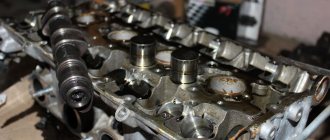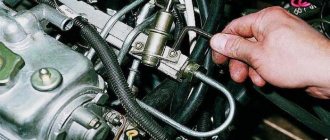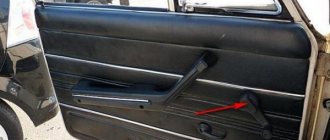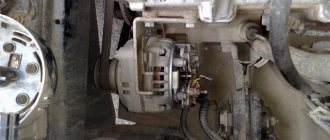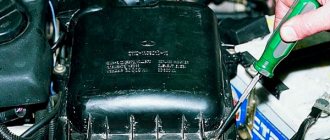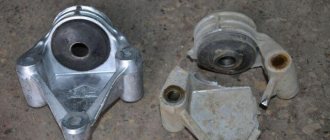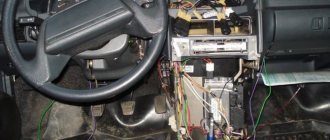Hello friends! I have a question. Well, that is, it’s overdue... I was browsing around the Stinger-Shop website, and came across such a PRODUCT.
And, in fact, the question itself. What, really, this thing can be installed on an eight-valve head and there will be no need to adjust the valves?
8v heads come without hydraulics. And what happens, can hydraulics be installed? If yes, then I ask for an explanation, guys. Thank you in advance!
FAT UPDATE!
As it turned out, these were 16v compensators, and the description was filled out incorrectly.
intake system, power supply, gas distribution...
Yes, a headache for owners of sixteen-valve “ten” cars is hydraulic valve clearance compensators. They often fail during the warranty period (100 thousand km). Sometimes the defect is in the part itself, sometimes low-quality oil is to blame. In any case, this engine requires good service.
Hydraulic compensators for VAZ 2114 8 valves: installation, malfunctions and repairs
Hydraulic compensators for the VAZ 2114 (GK, another name is hydraulic pushers) are self-regulating devices that automatically correct thermal valve clearances in the intake and exhaust systems.
The operation of such a device is based on the principle of incompressibility of engine oil. When the engine is running, oil constantly fills the internal cavity of the hydraulic compensator and, when a gap appears in the valve drive, moves the plunger, ensuring constant contact of the drive lever with the camshaft cam (without gap).
Hydraulic compensators for VAZ 2114 8 valves: installation, adjustment, replacement, additional lubrication
After installing the HA, the car engine begins to run much quieter, since the valves stop knocking. In addition, there is no need to periodically adjust the valves during vehicle maintenance.
The only condition that should be immediately noted is the need to fill in high-quality oil, since dirty oil can cause clogging of the hydraulic compensator mechanism. A constant supply of oil (under pressure) ensures uninterrupted operation of the hydraulic system.
This supply is carried out through a special channel that has a check ball valve, which, after turning off the engine, prevents oil from draining from the channel. In addition, on the lower plane of the bearing housings there are channels through which oil is supplied to the camshaft journals.
The presence of mechanical inclusions and other impurities in the oil leads to rapid wear of the plunger pair of the hydraulic valve and, as a consequence, severe wear of the camshaft cams.
The installed hydraulic compensators on the VAZ 2114 (8 valves) may, over time, begin to produce a characteristic knocking sound, which will indicate the presence of certain problems.
Among the main reasons for the appearance of such a sound, experts identify:
- Problems with the quality and purity of the oil or the use of the wrong brand, which does not have the appropriate viscosity, temperature characteristics, etc.
- Malfunctions of the oil system, namely:
- the presence of plaque and dirt in the oil channels;
- airing the system (the presence of air increases the oil compression rate);
- oil filter clogged;
- malfunction of the oil pump.
- Mechanical failures of the main body:
- presence of exhaustion in the plunger pair;
- problems with the correct operation of the oil supply valve (options: situational sticking or failure);
- defects on the surface of the hydraulic compensator.
It is important to note at what engine temperature a knock appears in the hydraulic tappets. If this happens when it is cold, and when it warms up sufficiently, the knocking disappears, then this situation is quite acceptable. If, on a fully warmed-up engine, the picture does not change and the sound does not disappear, then this indicates existing malfunctions that require elimination.
Principle of operation
The principle of operation is this: you turn the key in the lock, and current flows to the excitation wire. The magnetic field that the armature creates penetrates the stator windings, at the terminals of which voltage appears. When the armature reaches a sufficiently high rotation speed, which is provided by the pulley and belt drive, the so-called self-excitation mode occurs.
The rectifier unit converts alternating current into direct current. The voltage regulator starts working when the crankshaft speed changes (accordingly, the armature rotates faster or slower) and regulates the time for which the field wire is turned on. Sometimes a generator malfunction may occur due to a blown fuse in the circuit.
Hydraulic compensators for VAZ 2114: how to get rid of knocking
Experts recommend two ways to solve the problem:
- Changing the oil and oil filter is carried out when the oil has already used up some of its service life and has a bad odor and color (dark brown).
- Removing hydraulic tappets - used if adding oil does not solve the problem. The removed HAs need to be inspected and, if the wear is insignificant, then disassembled and washed separately.
During the process of removing hydraulic compensators, you should remember/write down where and which hydraulic compensator was installed previously. This way, during the reverse operation (reinstallation) there will be no problems.
To flush hydraulic compensators, the following steps should be performed sequentially:
- Open. When performing an autopsy, you should knock the core out of the housing. To do this, forcefully strike the glass with the open part of the glass (through the fabric) on a hard surface. After opening, two separate elements are obtained - the core and the body itself. The core consists of: a piston, a cylinder and a spring. The piston is easily removed from the cylinder.
Hydraulic compensators for VAZ 2109 8 valves
Tell me, can you install hydraulic compensators in a 2108 8 valve, for example with a 2112 or from another car?
It’s possible, there’s an oil channel nearby, but the hydraulic units need to be selected properly. why. The budget for this modification will be more expensive than installing a 16-valve head.
I support. It's cheaper to just adjust the valves regularly. But if you don’t do much and have an unlimited budget, everything is possible.
I had this happen once...
This question is also interesting...
this is not real, why even bother with this idea?
In fact, this is possible, but it is not economically feasible.
The topic is cool, a version of the ZMZ 406 hydraulic pushers... there are valves + springs + plates 2108... and the eighth glasses fit like family)
There is no way to install it, there are no oil supplies to each valve! It’s easier to replace the engine with something else, and it’s cheaper!
You tried? Just because you haven’t tried or don’t know how doesn’t mean it’s not possible. Not advisable, yes, but not impossible.
Just judge for yourself, for each hydraulic compensator, at the level of the oil supply groove, there is a channel in the head; our cars don’t have it! This means it won’t pump oil! that is, it will not work! And at home, you won’t be able to route from the main oil supply to the head to each valve, since it’s not intended!
There are some in our cars, just not in 8th grade. Don’t talk nonsense, friend.
Just judge for yourself, for each hydraulic compensator, at the level of the oil supply groove, there is a channel in the head; our cars don’t have it! This means it won’t pump oil! that is, it will not work! And at home, you won’t be able to route from the main oil supply to the head to each valve, since it’s not intended!
Expert answer
KZATE 115 Ampere
A 115 Ampere KZATE generator is installed from the factory. Its quality is truly below par. The diode bridges on it are lit “only on the road.” Very poor build quality.
Due to poor contact, the pad on the original generator burned out; all you had to do was tighten one bolt well
Bosch 135 Ampere
The most common replacement option is a Bosch 135 Ampere, especially since starting from 2016, all Grants are equipped with this particular model.
This is already a Bosch generator, it is what all Grants have been compiled with since 2016
The cost of a Bosch generator is about 5,000 rubles, but it is a very reliable manufacturer.
It is possible to restore an old original generator, but the master simply does not want to take on the work. This generator is made “disposable”; when disassembling it, it falls apart, and it is very difficult to roll everything back. Moreover, the wear and tear of the old “gene” could already be critical, and there the repair kit would cost like new.
Bulgarian generator 135 Ampere
I would recommend listening to the opinion of your master and purchasing a new one. I have a Bulgarian 135 Ampere generator installed, the flight is normal . When replacing, I recommend installing a bracket with a tensioner from Kalina, it is more thoughtful and convenient.
The device serves to transform mechanical energy from the crankshaft into electricity. The generator charges the battery and is also a source of alternating current and power for all electrical equipment of the car. It has a diode bridge (rectifiers) and a voltage regulation unit, operating in parallel with the battery.
Messages 12
1 Topic from Lada-2108 2011-03-12 09:51:14
- Lada-2108
- User
- Offline
- Registered: 2010-08-21
- Messages: 633
- Reputation: [ 0 | 0 ]
Topic: Hydraulic valve lifters!
The obvious advantage of hydraulic compensators is the absence of a gap between the pusher and the camshaft, and accordingly the “shock” loads are reduced! And there is no need to climb with a feeler gauge and measure the thermal gap =)
The current hydraulic compensator affects the “charged motor”. Do hydraulic compensators influence the valve timing? Is it possible to install a compensator on the head 083.
2 Reply from Gloomc 2011-03-12 09:55:56
- Gloomc
- User
- Offline
- Registered: 2010-08-07
- Messages: 32
- Reputation: [ 0 | 0 ]
Re: Hydraulic valve lifters!
Well, in 12 cars, after all, hydraulics are immediately available in stock))
but putting them in the 8th head is a controversial issue
3 Reply from Lada-2108 2011-03-12 10:00:55
- Lada-2108
- User
- Offline
- Registered: 2010-08-21
- Messages: 633
- Reputation: [ 0 | 0 ]
Re: Hydraulic valve lifters!
Well, in 12 cars, after all, hydraulics are immediately available in stock))
familiar, I just basically want to understand that they are needed to “charge” the engine, and how they affect the operation of the engine, or their role is purely to avoid poking with a dipstick.
4 Reply from Konstantin 10 ru 2011-03-12 11:26:45
- Konstantin 10 ru
- User
- Offline
- Registered: 2009-09-01
- Messages: 353
- Reputation: [ 1 | 0 ]
Re: Hydraulic valve lifters!
They are on the classic with the 8th head.
5 Reply from Lada-2108 2011-03-16 17:09:36
- Lada-2108
- User
- Offline
- Registered: 2010-08-21
- Messages: 633
- Reputation: [ 0 | 0 ]
Re: Hydraulic valve lifters!
They are on the classic with the 8th head.
What a classic, and even with 8 heads, and even with hydraulic pushers. injector chtoli 21074.
6 Reply from MasterGray 2011-03-17 08:44:22
- MasterGray
- User
- Offline
- Registered: 2008-11-10
- Messages: 411
- Reputation: [ 0 | 0 ]
Re: Hydraulic valve lifters!
Probably 21214 motor. but there is no 8 head there.
7 Reply from Konstantin 10 ru 2011-03-17 10:42:16
- Konstantin 10 ru
- User
- Offline
- Registered: 2009-09-01
- Messages: 353
- Reputation: [ 1 | 0 ]
Re: Hydraulic valve lifters!
on the shnivy there is a head of 8 valves with compensators, I expressed it incorrectly in the previous post.
8 Reply from MasterGray 2011-03-18 09:32:30
- MasterGray
- User
- Offline
- Registered: 2008-11-10
- Messages: 411
- Reputation: [ 0 | 0 ]
Re: Hydraulic valve lifters!
The mechanism there is completely different; I bought them with my own penny back in the day. very disappointed
9 Reply from Lada-2108 2011-03-18 11:03:41
- Lada-2108
- User
- Offline
- Registered: 2010-08-21
- Messages: 633
- Reputation: [ 0 | 0 ]
Re: Hydraulic valve lifters!
The mechanism there is completely different; I bought them with my own penny back in the day. very disappointed
Well, yes, the classics have rocker arms. As far as I understand, we are talking specifically about the 08 head in the shnivy. or I didn't understand something.
Hydraulic compensators for the VAZ 2114 (GK, another name is hydraulic pushers) are self-regulating devices that automatically correct thermal valve clearances in the intake and exhaust systems.
The operation of such a device is based on the principle of incompressibility of engine oil. When the engine is running, oil constantly fills the internal cavity of the hydraulic compensator and, when a gap appears in the valve drive, moves the plunger, ensuring constant contact of the drive lever with the camshaft cam (without gap).
Device components
If the generator device is considered in terms of size, then there are compact and traditional ones. They also differ in their design features.
- drive pulley;
- excitation wire;
- bracket;
- anchor device.
They can be fastened with one bolt, or with several, and other “little things”. However, any generator has a general structure.
- The rotor (or armature) is the rotating part of the generator. The armature is designed to create a magnetic field using an excitation winding located on the shaft. The excitation wire is powered by slip rings located on the same shaft. The following are also located here: the excitation winding wire, the fan impellers (one or two), the drive pulley and the bearing assembly;
- The stator is the stationary part of the generator, consisting of three windings (three-phase), which create alternating current. These windings can be connected to each other by the so-called “star” or “delta”;
- The housing is most often made of lightweight non-magnetic aluminum alloy; it consists of two covers, secured with a bolt. The front cover is located in the same place as the drive pulley; the back cover is on the side where the slip rings are. Each bolt that connects the back and front covers is tightened. In the future, to disassemble the generator on a VAZ 2110, it is enough to remove the bolt mounts;
- Mounting the generator on a VAZ 2110. There is an upper mounting bracket that uses 2 bolts. The lower mounting bracket most often has one bolt, but there may be two, in which case minor modifications may be necessary. The bolt can be anything, the main thing is that the size is suitable, sometimes a sleeve is required for this. It is better not to redo the bracket itself. The bracket securely holds the generator, which has many responsibilities. And yet, we should not forget that the bracket, like the bolt, can break, so you need to monitor its condition;
- The structure of the brush assembly consists of two graphite brushes, springs that press them, and a brush holder;
- In modern Katek generators, the voltage wire and brush holder are located together in a non-separable unit. Therefore, if the voltage regulator fails, the entire assembly must be replaced. Structurally, this regulator can have a hybrid device - when radio elements with electronic devices are in the same circuit. But an integral is when the regulator is made in thin-film microelectronics technology. Many believe that the integral regulator copes better with its mission - controlling the duration and frequency of current pulses. The regulator changes the voltage used to charge the battery. At higher temperatures, less voltage goes to the battery. Although, in principle, it is not so important whether the integral is responsible for this regulation, or the hybrid;
- A rectifier unit with six diodes is responsible for converting the alternating current generated by the armature and stator into direct current, directly used by all on-board equipment. It also serves to charge the battery;
- The device is driven by a belt drive. It provides a significant increase in the speed at which the crankshaft rotates. In this case, the V-belt wears out faster if the pulley has a small diameter. If the driven pulley is small, it is better suited to a serpentine drive, which is more often used in modern generators.
Here, in brief, is the basic structure of generators, regardless of whether they produce 80 or 120 amperes.


